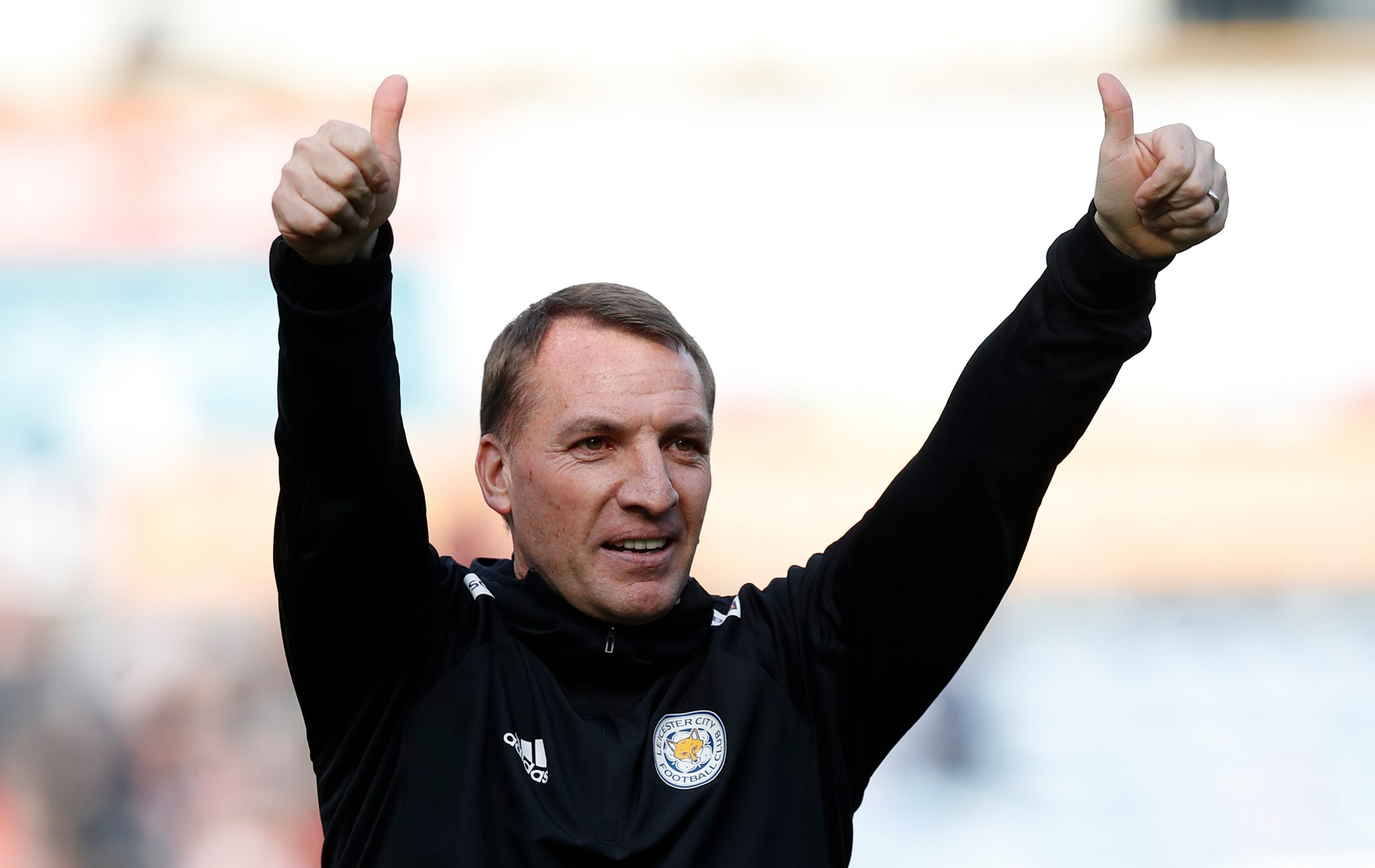Clubs that reside outside the big six in the Premier League, the likes of Everton, West Ham, and recent newcomers Wolves, hope for an opportunity to take advantage of chaos at the top of the table to wiggle their way past a struggling member of the Big Six. With appropriate planning and forethought, and the accumulation of young to early-prime talent along with a credible manager, the ingredients could be in place to concoct the type of magical season that would be remembered for years to come. The 2019–20 season has the potential to be that slight window of an opportunity that these clubs have been waiting for, with Arsenal, Manchester United, and Chelsea all having their respective issues that could, if things go pear shaped, take them out of the running.
Leicester City might be the club best equipped to make that jump. The last time the PL table didn’t have the same six teams at the top was 2015-16, which doubled as Leicester's miracle title run. Though the three seasons that followed were anything but smooth, Leicester have emerged with the building blocks needed to have another memorable campaign. They have a squad with the top end talent to compete, along with enough depth in midfield and attack to withstand a reasonable amount of injuries occurring during the season. Without European football to deal with, it's hard to see a better opportunity presenting itself in the near future than what's in front of Leicester currently.
Metrics
It’s interesting to look at how Leicester fared statistically under both Claude Puel and his eventual successor Brendan Rodgers during the 2018–19 season. Under Puel, Leicester were never a bad side and maintained a certain level of competence with the 12th best attack and 7th best defense according to expected goals, but it was clear that the style of football being played wasn’t exactly exciting the masses. What was particularly striking was that Leicester profiled as a side that defended deep but couldn’t attack with pace, ranking 16th in how high up the pitch they made their defensive actions and having the 6th slowest attack in terms of speed of buildup for possessions that ended with shots. Defending deep isn’t necessarily a bad thing, but not being able to strike fear in the opponent on the counter can make for a frustrating watch.
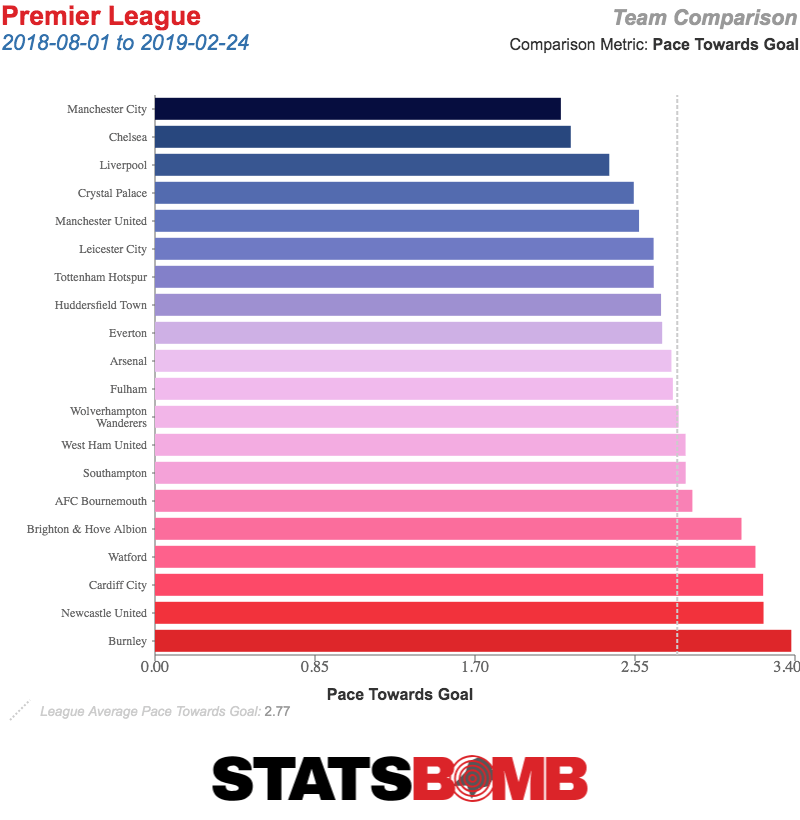
It’s not hard to see why Leicester ended up making a managerial change, even though they probably could’ve stuck it out with Puel for the remainder of the season and remained a mid-table outfit. The switch to Rodgers, a manager who has made his reputation as one who is not shy to switch between different playing styles, yielded immediate results primarily through an increase in attack. In the 10 matches to end the season when Rodgers was in charge, Leicester ranked fourth in open play expected goals, seventh in shots, and fifth in clear shots generated (situations when there's only the goalkeeper in between the shot-taker and goal). In the limited sample, Leicester looked like a club that stumbled onto something quite intriguing.
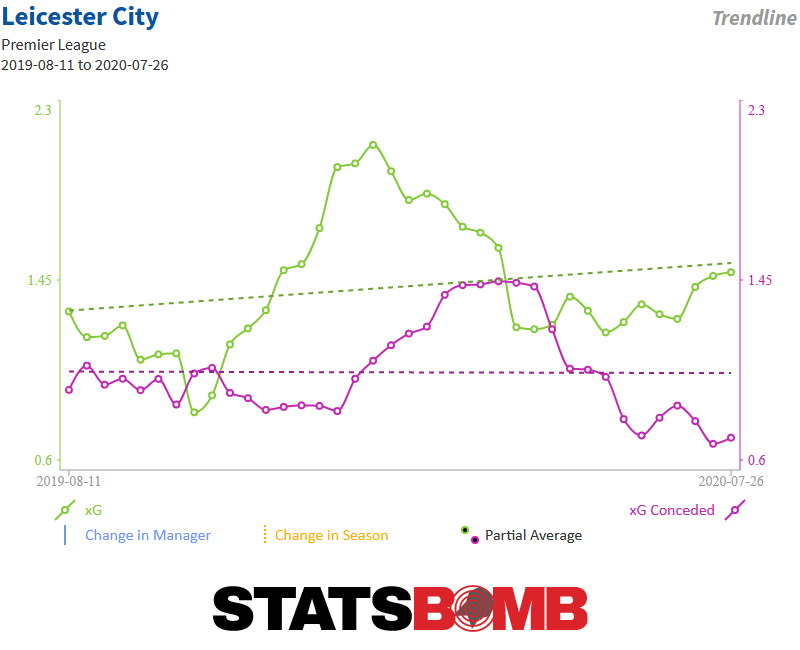 Another difference, albeit a slighter one, between Puel and Rodgers was how the team defended and their ability to turn defense into offense. Under Rodgers, Leicester were around league average in how high up the pitch they made defensive actions, and above league average in passes per defensive action. Leicester were similarly solid but unspectacular in generating transition opportunities, ranking ninth in shots coming via a defensive action in the opposition half in five or less seconds and eighth in counter attacking shots. No one would confuse them with being an incredible pressing side that turned turnovers into scoring chances at will, but they were able to do it at a greater frequency than during the earlier parts of the season. Now, there are ways to poke holes at Leicester's promising performance during the final 2.5 months of the season. For one, we only have 10 games of evidence with Rodgers at the helm and those games came at the end of the season. While playing well in a 10 game sample size isn't something to turn your nose up at, it's still a small enough number that various factors could play a role in that success. Their schedule was also rather weird. While Leicester did perform admirably against Arsenal, Manchester City and Chelsea to end the season; they also got to play the likes of Fulham, West Ham, Huddersfield, Watford when they were on their second half slide, and Bournemouth.
Another difference, albeit a slighter one, between Puel and Rodgers was how the team defended and their ability to turn defense into offense. Under Rodgers, Leicester were around league average in how high up the pitch they made defensive actions, and above league average in passes per defensive action. Leicester were similarly solid but unspectacular in generating transition opportunities, ranking ninth in shots coming via a defensive action in the opposition half in five or less seconds and eighth in counter attacking shots. No one would confuse them with being an incredible pressing side that turned turnovers into scoring chances at will, but they were able to do it at a greater frequency than during the earlier parts of the season. Now, there are ways to poke holes at Leicester's promising performance during the final 2.5 months of the season. For one, we only have 10 games of evidence with Rodgers at the helm and those games came at the end of the season. While playing well in a 10 game sample size isn't something to turn your nose up at, it's still a small enough number that various factors could play a role in that success. Their schedule was also rather weird. While Leicester did perform admirably against Arsenal, Manchester City and Chelsea to end the season; they also got to play the likes of Fulham, West Ham, Huddersfield, Watford when they were on their second half slide, and Bournemouth.
Transfers
Undoubtedly, the biggest transfer that’s happened for Leciester is the departure of Harry Maguire to Manchester United for a fee around £80 million, which makes it the most expensive transfer fee given to a defender. It’s not impossible to see how this fee got to as high a number as it did. Maguire is an accomplished prime age center-back who played for a mid-table side, he is an English talent who had a notable role in England’s semifinal run in the 2018 World Cup, and the interested buyer in question was Manchester United. Leicester did well to milk United for such a high figure given that while Maguire would probably rate as above average relative to his position with the overall capacity to scale up to a super club, he will be seen as a considerable overpay at his price unless he becomes an unambiguous elite player in a manner similar to what's happened with Virgil Van Dijk.
What Leicester did in terms of accumulating talent for a potential push up the table makes for an interesting discussion. Getting Youri Tielemans on a permanent transfer is a coup given that he was linked to bigger clubs at different points over the past few months, though getting him to commit to a long term future didn’t come cheap with his transfer fee at around £40 million representing a huge investment. Tielemans was quite productive during his half season in the PL, particularly when Leicester were able to play a midfield three featuring himself, James Maddison, and Wilfried Ndidi. The combing of him and Maddison patrolling the right and left half-spaces respectively as creative hubs gave Leicester the create midfield talent needed to become more proactive in possession and dictate play against lesser opponents. It's not hard to envision that being the default midfield configuration given how the skillset of those three players blend quite well, with Ndidi giving Maddison and Tielemans the platform to succeed higher up the pitch.
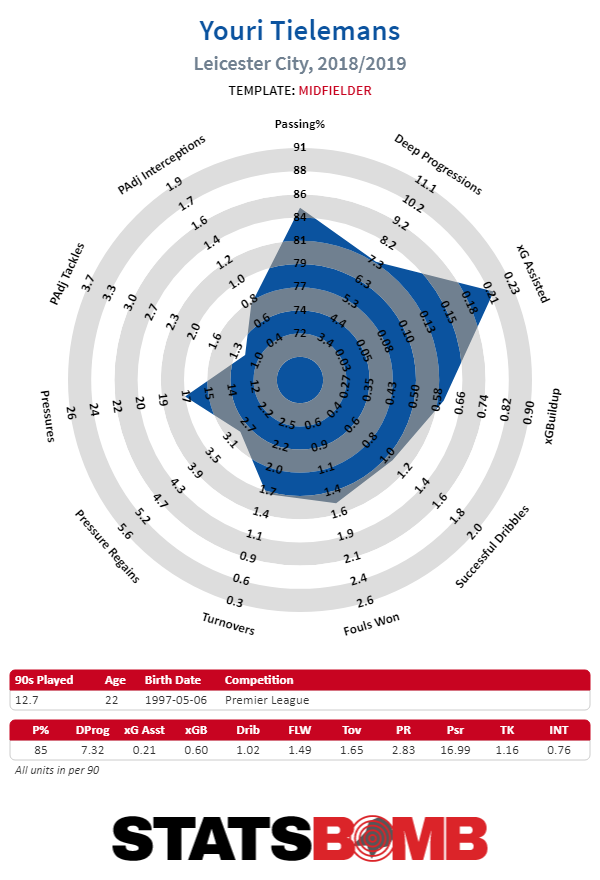
The acquisition of Ayoze Perez at £30 million is one that perhaps has a few more question marks to it. In isolation, Perez' numbers weren't bad, a non-penalty scoring contribution per 90 rate of 0.40 is perfectly acceptable, despite having below league average shot volume. It’s certainly fair to point out that Newcastle have been one of the worst attacking sides in the Premier League over the past couple of seasons, and so the fact that Perez has essentially performed like a league average attacker might be indicative of someone who could be considerably better if surrounded by better talent, which will be the case at Leicester. It’s an argument that holds some sway, and it’s not unreasonable to think that this was part of the reasoning behind Leicester targeting him this summer.
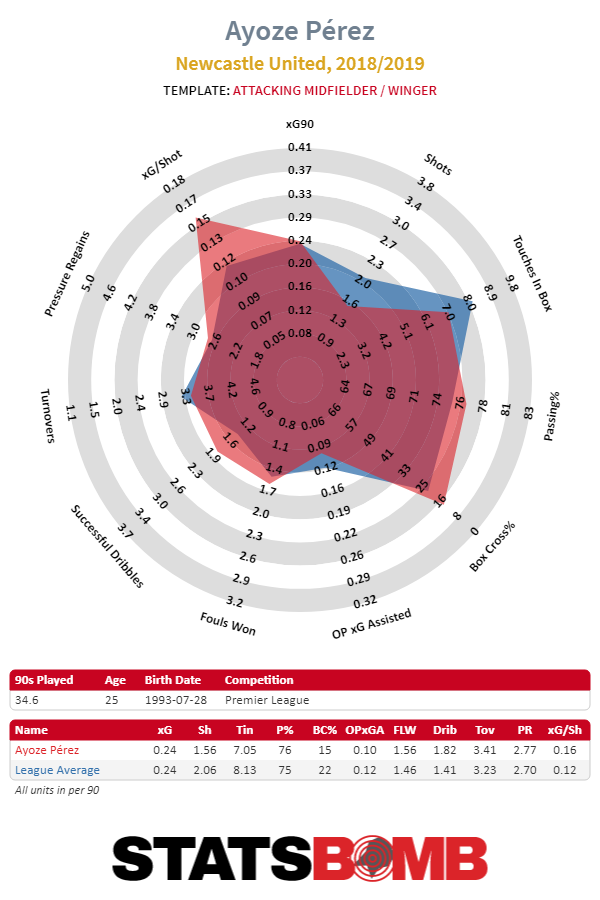
The biggest criticism I would have of the deal, though I wouldn't necessarily call it a major one, is that could they have done better going elsewhere to find a wide attacker to compliment what's already in place. It’s hard to find value within the Premier League given how absurdly rich a lot of clubs are in the division through years of pocketing that lavish TV money. More times than not, you're having to overpay for talent within the division and regret it not too long after. While I don't think Perez at his price will turn out to be anything resembling an albatross, there perhaps might've been better options to get more bang for your buck. If they were looking for more of a prospect type with a focus on future upside, Ismaila Sarr would've been an intriguing candidate given his skill intersection of functional athleticism and chance creation on the right wing to complement Harvey Barnes' high shot volume on the left. If Leicester were insistent on acquiring a prime age wide player for the present, Florian Thauvin would've been a candidate given his consistent production since coming back to Marseille.
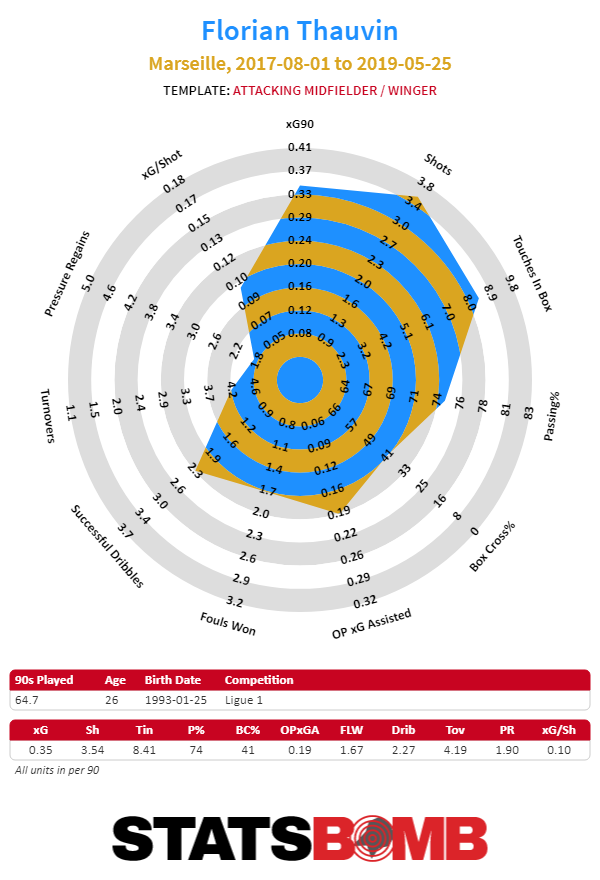
Put it all together, and despite some of my apprehension, it would be inaccurate to say that Leicester had a crippling or simply even a bad transfer window. Selling at absolute peak value on a good but not necessarily great (at least for now) center back in Maguire is great business, particularly when having the likes of Johnny Evans, Filip Benković and Çağlar Söyüncü should be good enough in central defense to get by for the upcoming season. Retaining Tielemans was important, and the transfer fee needed to keep him will look like sound business so long as his form with Leicester last season becomes the standard level of play for him. If Perez turns out to be an above average contributor, then concerns over his price tag will dissipate. Could Leicester have been more creative in addressing their needs, particularly the wide areas? I think there's a case to be made for that, but if things go their way, this could be an instance where creativity wasn't needed.
2019–20 Outlook
For all the positives that have been said about Leicester's chances for this upcoming season, it's possible that enough things don't break their way and instead of challenging for top 6 or perhaps even getting as far as sneaking into the final Champions League spot, 2019-20 amounts to another run of the mill season in the 47-52 point range. A fair amount of optimism on Leicester's chances is based on 10 games last season, and while they had a fairly strong statistical profile during that time span, it is still only 10 games that we're talking about. Over the years, we've seen a number of promising 10 game sample sizes that over time didn't amount to something more substantial. It also might be that we've overestimated just how close the gap has shrunk between the Arsenal/Man U/Chelsea tier and the chasing pack below them. On the other hand, it's hard to deny there being a tantalizing upside that exists for Leicester, however skeptical one might be of them actually realizing it. The high end talent fits rather well, to go along with enough competent depth to help withstand the rigors of the season. Leicester employ two of the better full-backs in the Premier League in Ben Chilwell and Ricardo Pereira, the midfield is solid, and there are attacking options available that can be used in different ways. Barnes is a candidate to potentially make the leap, and while Leicester don't necessarily need that to happen for them to have a successful season, it certainly wouldn't hurt. One way in which PL clubs can bridge the gap in resources vs the elite and migrate up the division is from riding the coattails of a young player making the leap from good to great. Added intrigue with Leicester this season is that this represents another data point in figuring out just how good Brendan Rodgers is as a manager. Another way to make up the difference in resources for smaller PL clubs is finding a manager who is a no doubt net-positive, though that is perhaps harder to do now in the PL than it was a few seasons ago given how good the league's overall managerial talent has gotten. Among Rodgers' highlights is helping continue Celtic's domestic dominance in Scotland, overachieving with Swansea both in the Championship and Premier League, and the miraculous 2013-14 runner-up season with Liverpool. Of course, that near title thrill ride is sandwiched between seventh and sixth place finishes, along with the disappointing start in his fourth year that got him sacked. Successfully creating something substantive with Leicester this season would help quiet some of the skepticism that exists on Rodgers' managerial chops. If there ever was a season where the Premier League table was in for a considerable shakeup, 2019-20 is that opportunity for chaos, and Leicester just might have enough to once again shake up the status quo. Header image courtesy of the Press Association
